Housetop Apostolate
When I was appointed to support the communications apostolate for our mission territories worldwide, Jackie and I jointly founded Housetop in London. I have narrated the story in earlier chapters. In 1984 we established the corresponding Charity: Housetop Trust. Jackie, I and Sr Anne Miller FMM were its first trustees. We found a home for our Centre in 111 Homer Street, Paddington. This was a very narrow but tall house. We had our lounge and prayer room in the basement, a small office on the ground floor, the kitchen and Jackie’s bedroom/office on the first floor, my bedroom and office on the top floor.
Jackie played a key role in the Centre. During our seven starting years she held the fort when I was away for five months each year to give courses in India. She kept the accounts – a crucial job since we had to submit these each year to the Charity Commission. She dealt with correspondence, received visitors and provided counselling when necessary. This was a huge task especially during the long period when we had been entrusted by the Archbishop of Westminster with pastoral care for people caught up in the so-called cults & sects. I have explained more about it here.
More than once Jackie and I undertook joint projects on the missions. One was our helping the Catholic Bishops Conference of Pakistan set up its new programme of communication. I have described it here. Another was an updating course we gave in Kisubi north of Kampala for religious superiors from the whole of Uganda.
Biblical illustrations
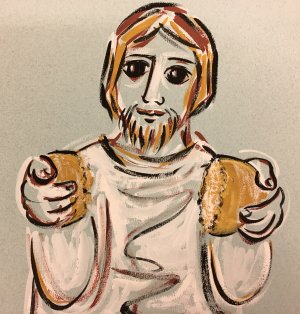
illustration by Jackie
In earlier chapters I have described our work on the Walking on Water video courses. The videos presented contemporary stories interrupted by ten-minute reflection slots. Many of these slots contained illustrations from the Gospels. Now from our experience in India Jackie and I were well aware of the damage done to the Gospel message when missionaries use Western imagery to present the Gospel.
Italian missionaries, for example, built churches in India modelled on what they had been used to at home. Through imported statues Jesus, Mary, Joseph and the Apostles were presented as white-faced Europeans. Gospel scenes on paintings or in catechism books were copied from material produced in Naples or Florence. The result was that many Christians – as well as Hindus – perceived Gospel personalities as distinctly colonial individuals. It became an obstacle to them absorbing the Gospel as a reality that could become flesh in their own culture.
For that reason, while still in India, I avoided at all costs permitting western imagery for the biblical message. I have recounted earlier how happy I was finding non-colonial line drawings for my book Background to the Gospels. Also I helped create the indianised film story of the Life of Christ Karunamayudu and I wrote the script for the Indian comic book version of the life of Christ in the Amar Chitra Kadha series.
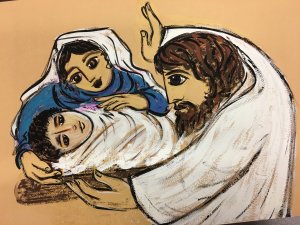
At Naim Jesus raises the widow’s son to life, by Jackie
So Jackie and I realised that we need special Gospel illustrations for our Walking on Water video courses. After all, these courses had to be used by audiences on all five continents. Jackie was the perfect artist to create these. When depicting Jesus Christ for instance she designed portrayals of him in simple bold format that clearly revealed his middle-east origin and could not be misinterpreted as white Caucasian.
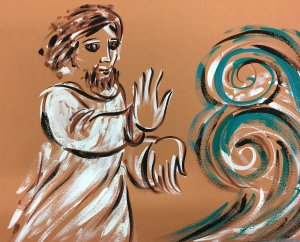
Jesus calms the storm on the lake, illustration by Jackie
She also avoided clinging to one standard picture in all representations of Jesus. The focus lay on making viewers reflect on Jesus as a true human being like all of us and on bringing out his dramatic impact in each specific scene. It was important, after all, to enable each spectator to fully re-embody in his or her personal culture-shaped imagination. Her contribution to the effectiveness of our video courses was therefore of great value.
The power of Jackie’s art
In our own days we have become use to producing photographic imagery with great ease. Even simple mobile phones can now deliver photographs of amazing high quality. Many people therefore think that dramatized filmed reconstructions of Gospel stories would be the most efficient means to bring those stories to life. But nothing is further from the truth. Artistic representations can achieve much more as I will demonstrate in the parable of Lazarus and the rich man.
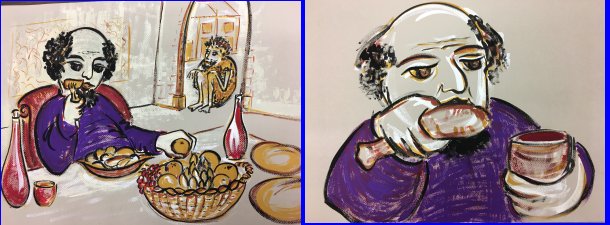
illustrations by Jackie
The Gospel says: “There was a rich man who was dressed in purple and fine linen and lived in luxury every day” (Luke 16,19). In Jesus’ time, purple cloth and linen could only be afforded by the wealthiest in society.
In her portrayal of the rich man Jackie presents a person who easily be recognised by people all over the world as someone who is well off. He is sitting comfortably. Delicious food and drink stand before him on the table. The close-up of him biting into a piece of roasted fish expose his relish in sumptuous dining.
Now, if this had been represented in a photographic image, the scene would be identified as having taken place in a specific place and time, involving a particular individual eating identifiable dishes. On the other hand, in Jackie’s painting all these things – spacious room, purple dress, sumptuous food – now assume a symbolic meaning. For instance, a woman viewing the image can identify herself with it, reflecting on her love of jewels, of driving her expensive car and enjoying a luxurious holiday in a beach resort.
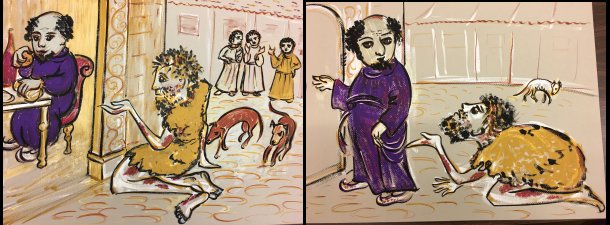
illustrations by Jackie
Jesus continues: “At his gate was laid a beggar named Lazarus, covered with sores and longing to eat what fell from the rich man’s table. Even the dogs came and licked his sores.” Some scripture commentators have searched for a deep theological meaning in the dogs licking the beggar’s sores. “Why otherwise does Jesus mention the dogs?”, they wonder. “He could have left them out of the parable.” But these interpreters are mistaken. The dogs licking the sores have no separate theological significance. Jesus just adds them to make the plight of the beggar even more stunning, to make it contrast more graphically with the comfort of the rich man.
In her depictions of Lazarus Jackie highlights his abject condition. Half-naked he lies on his knees, unable to keep the dogs away from his wounds. He begs the rich man for food. Again the image rises above the limits of a specific photograph. It depicts utter misery, total dependence on the generosity of the rich man. Notice how details of the rich man’s house, the street, the neighbourhood recede into the background. Full focus falls on the details that count. This is what an image can do, and Jackie mastered this skill extremely well.
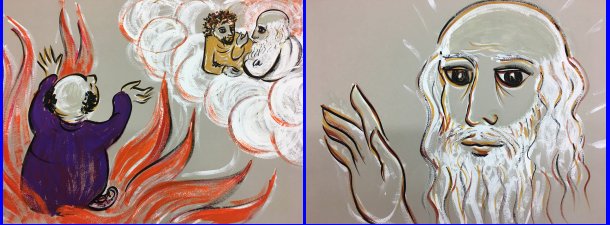
illustrations by Jackie
The parable then states: “The time came when the beggar died and the angels carried him to Abraham’s side. The rich man also died and was buried. In Hades (hell), where he was in torment, he looked up and saw Abraham far away, with Lazarus by his side. So he called to him, ‘Father Abraham, have pity on me and send Lazarus to dip the tip of his finger in water and cool my tongue, because I am in agony in this fire.’ But Abraham replied, ‘Son, remember that in your lifetime you received your good things, while Lazarus received bad things, but now he is comforted here and you are in agony, etc.’
Photography would totally fail here. Jackie’s images are simple but easy to understand. The rich man standing in the flames of hell looking across a wide chasm up to heaven where Lazarus is enjoying the company of Abraham, the revered ancestor of the Jewish people. Jackie’s art excels in powerful strokes that emphasize the features that matter. The message can be comprehended by every culture under the sun.
Next Poetry
THE STORY OF MY LIFE
- » FOREWORD
- » Part One. LEARNING TO SURVIVE
- » origins
- » into gaping jaws
- » from the pincers of death
- » my father
- » my mother
- » my rules for survival
- » Part Two. SUBMIT TO CLERICAL DOGMA — OR THINK FOR MYSELF?
- » seeking love
- » learning to think
- » what kind of priest?
- » training for battle
- » clash of minds
- » lessons on the way to India
- » Part Three (1). INDIA - building 'church'
- » St John's Seminary Hyderabad
- » Andhra Pradesh
- » Jyotirmai – spreading light
- » Indian Liturgy
- » Sisters' Formation in Jeevan Jyothi
- » Helping the poor
- » Part Three (2). INDIA – creating media
- » Amruthavani
- » Background to the Gospels
- » Storytelling
- » Bible translation
- » Film on Christ: Karunamayudu
- » The illustrated life of Christ
- » Part Three (3). INDIA - redeeming 'body'
- » spotting the octopus
- » the challenge
- » screwed up sex guru
- » finding God in a partner?
- » my code for sex and love
- » Part Four. MILL HILL SOCIETY
- » My job at Mill Hill
- » The future of missionary societies
- » Recruitment and Formation
- » Returned Missionaries
- » Brothers and Associates
- » Part Five. HOUSETOP LONDON
- » Planning my work
- » Teaching teaching
- » Pakistan
- » Biblical Spirituality
- » Searching God in our modern world
- » ARK2 Christian Television
- » Part Five (2) New Religious Movements
- » Sects & Cults
- » Wisdom from the East?
- » Masters of Deception
- » Part Five (3). VIDEO COURSES
- » Faith formation through video
- » Our Spirituality Courses
- » Walking on Water
- » My Galilee My People
- » Together in My Name
- » I Have No Favourites
- » How to Make Sense of God
- » Part Six (1). RESIGNATION
- » Publicity
- » Preamble
- » Reaction in India
- » Mill Hill responses
- » The Vatican
- » Part 6 (2). JACKIE
- » childhood
- » youth and studies
- » finding God
- » Mission in India
- » Housetop apostolate
- » poetry
- » our marriage
